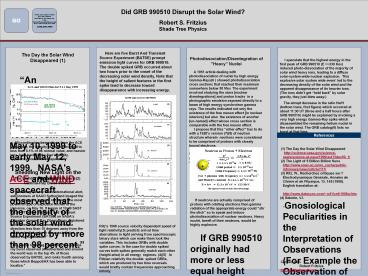48x36 Poster Template - PowerPoint PPT Presentation
1 / 1
Title:
48x36 Poster Template
Description:
Title: 48x36 Poster Template Subject: Free PowerPoint poster templates Keywords: poster presentation, poster design, poster template Description – PowerPoint PPT presentation
Number of Views:63
Avg rating:3.0/5.0
Title: 48x36 Poster Template
1
Did GRB 990510 Disrupt the Solar Wind? Robert S.
FritziusShade Tree Physics
Order your poster onlineby 3 pm Easternand
have it by tomorrow fromPosterPresentations.com
Please confirm current prices online 1.866.649.30
04
GO
Here are five Burst And Transient Source
Experiment (BATSE) prompt emission light curves
for GRB 990510. The double spiked GRB occurred
about two hours prior to the onset of the
decreasing solar wind density. Note that the
height of salient features in the first spike
tend to decrease toward disappearance with
increasing energy.
The Day the Solar Wind Disappeared (1) An
unprecedented solar wind disruption took place on
May 10, 1999. From late May 10, 1999 to early May
12, 1999, NASA's ACE and WIND spacecraft
observed that the density of the solar wind
dropped by more than 98 percent.
Photodissociation/Disentegration of
"Heavy" Nuclei A 1951 article dealing with
photodissociation of nuclei by high energy
Gamma-Rays(6 ) showed photodissociation cross
sections that reached their maximum somewhere
below 50 Mev. The experiment involved studying
the stars nuclear disentegrations and proton
tracks in a photographic emulsion exposed
directly to a beam of high energy synchrotron
gamma rays. The results indicated not only the
existence of the free meson effect in nuclear
interiors but also the existence of another
un-named effect whose cross section is
comparable with the free meson effect. I
propose that this other effect has to do with a
1920s version (7)(8) of neutron structure
wherein neutrons were considered to be comprised
of protons with closely bound electrons.
The following calculation indicates that bare
(unbound) 1920s neutrons might have
photo-dissociation cross section peaks at about
123 Mev.
I speculate that the highest energy in the
first peak of GRB 990510 (E gtgt330 Kev) induced
photo-dissociation of the majority of solar wind
heavy ions, leading to a diffuse
solar-system-wide nuclear explosion. This
explosive solar system wide event led to the
decreasing density of the solar wind and the
apparent disappearance of its heavier ions. (The
ions didnt get held back by solar gravity,
they just blew away.) The abrupt decrease in
the ratio He/H (bottom trace, first figure) which
occurred at about 1130 UT (three and a half
hours after GRB 990510) might be explained by
invoking a very high energy Gamma-Ray spike which
disassembled the remaining helium nuclei in the
solar wind. The GRB catalog(9) lists no burst at
that time.
References
"According to observations from the ACE
spacecraft, the density of helium dropped to less
than 0.1 of its normal value, and heavier ions,
held back by the Sun's gravity, apparently could
not escape at all. Shedding New Light on the
Problem
(1) The Day the Solar Wind Disappeared
http//science.nasa.gov/science-news/science-at-na
sa/1999/ast13dec99_1/ (2) The Light of 5 Billion
Billion Suns http//www.saao.ac.za/no_cache/pub
lic-info/news/news/article/117/ (3) Ritz, W.,
Recherches critiques sur l Électrodynamique
Générale, Annales de Chimie et de Physique, 13,
145 (1908). English translation at
http//www.datasync.com/rsf1/crit/1908a.htm (4)
Sekerin, V.I. Gnosiological Peculiarities in
theInterpretation of Observations (For Example
the Observation of Binary Stars) Translated from
Russian http//www.datasync.com/rsf1/sekerin.htm
(5) Fritzius, R. A Ritzian Interpretation of
Variable Stars http//www.datasync.com/rsf1
/binaries.htm (6) Seishi Kikuchi, Nuclear
Photodissociation by High Energy Synchrotron
Gamma-Rays, Phys. Rev., 86, 41 (1952) (7)
Harkins, W. D., J. Am. Chem. Soc. 42, 1956
(1920) (8) Rutherford, E., Proc. Roy. Soc. A, 97,
374 (1920) (9) The BATSE Current Gamma-Ray Burst
Catalog http//www.batse.msfc.nasa.gov/batse/grb/c
atalog/current/tables/basic_table.txt
The Light of 5 Billion Billion Suns(2) Gamma-Ray
Burst 990510 Reacting quickly to an
international alert, astronomers at SAAO
Sutherland imaged the fading glow of a 'gamma ray
burst', the most powerful type of explosion known
in the Universe, on May 10. It began at 1049
SAST 0849 UT when the Burst and Transient
Source Experiment (BATSE) on NASA's Compton Gamma
Ray Observatory registered an intense burst of
gamma rays from a direction less than 10 degrees
away from the south celestial pole, in the
constellation called the Chameleon. The
power reaching Earth from the gamma ray burst
observed at Sutherland and around the world was
in the top 4 of those observed by BATSE, and
ranks fourth among those which BeppoSAX has been
able to localize.
If neutrons are actually comprised of
protons with orbiting electrons then gamma
radiation of the appropriate energy could stir
the stick so to speak and induce
photodissociation of nuclear neutrons. Heavy
nuclei, bereft of their neutrons, would be highly
explosive. If GRB 990510 originally had more
or less equal height spikes (all the way through
the gt 330 keV band) then the energy in first
spike could have been absorbed by the debris
from the photo-dissociated solar wind ions. The
closer to the photo-dissociation energy regime
the greater the absorption. The absorption
process would have occurred in a very small
fraction of a second while thedeparting nuclear
fragments were behaving as expanding plasma
pockets. The second spike would have few plasma
pockets to encounter and would thus retain most
of its original amplitude.
Ritzs 1908 source velocity dependent speed of
light relativity(3) predicts arrival time
aberrations in light arriving from spectroscopic
binary stars which can make them look like
variables. This includes GRBs with double spike
curves. In the case for double spiked curves both
spikes generally match each other (height-wise)
in all energy regimes. (4)(5) In Ritzian
relativity the double spiked GRBs, which are
produced by two time reversals would briefly
contain frequencies approaching infinity.
Contact
Info. Robert Fritzius
fritzius_at_bellsouth.net
http//www.shadetreephysics.com































